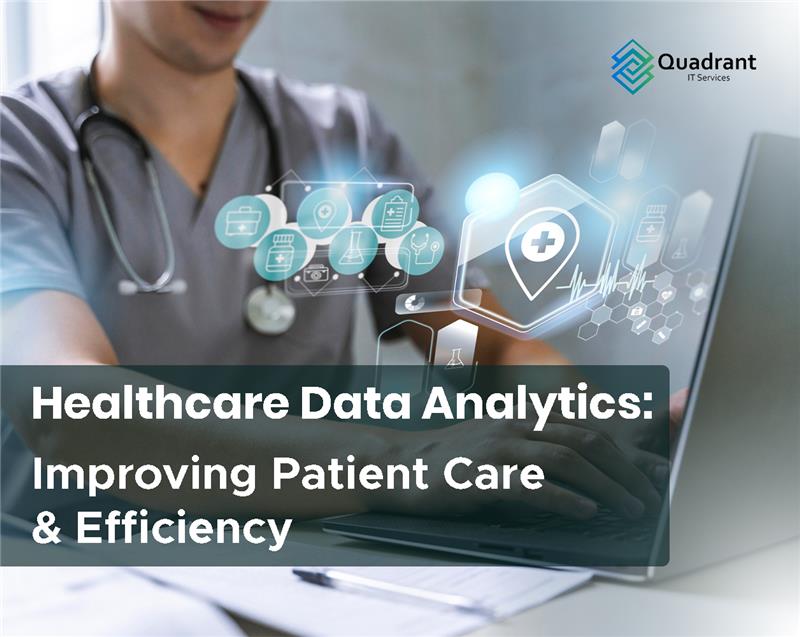We all know that data has become the lifeblood of every industry. Across industries, data is the cornerstone of informed decision-making. Businesses analyse consumer behaviour, track market trends, and predict future demands using vast amounts of data. In manufacturing, predictive maintenance helps avoid costly downtime. In retail, personalized marketing strategies are crafted by analysing customer purchase patterns. Even in transportation, real-time data is used to optimize routes and improve logistics. This data-driven approach improves efficiency and creates competitive advantages for businesses.
In healthcare, data analytics Services are rapidly transforming the way we deliver care and manage patient outcomes. By leveraging advanced analytics tools and big data technologies, the healthcare industry is not only improving operational efficiency but also enhancing patient care in once unimaginable ways.
What is Healthcare Data Analytics?
Healthcare data analytics refers to the process of collecting, analyzing, and interpreting vast amounts of health-related data to improve decision-making in healthcare settings. It involves the use of statistical tools, machine learning algorithms, and predictive models to uncover patterns and insights that can drive better patient outcomes. From EHR analytics to clinical analytics, healthcare data analytics encompasses several areas:
- Patient Data Analytics: Focuses on individual patient data, including medical history, diagnostic information, and treatment outcomes.
- EHR Analytics: Involves the systematic analysis of electronic health records to identify trends, predict patient risks, and optimize care delivery.
- Clinical Analytics: Utilizes clinical data to evaluate treatment effectiveness, monitor disease progression, and support evidence-based practices.
- Predictive Healthcare Analytics: Uses historical and real-time data to forecast future trends, such as predicting disease outbreaks or patient readmissions.
- Big Data in Healthcare: Involves analyzing large datasets from diverse sources, such as genomics, medical imaging, and wearable devices, to uncover hidden patterns and correlations.
The integration of Electronic Health Records (EHRs), medical imaging, genomic sequencing, and wearable health devices has resulted in an explosion of available patient data. However, the challenge lies in converting this massive volume of data into actionable insights. This is where healthcare data analytics comes into play. By harnessing the power of data analytics, healthcare providers can improve clinical outcomes, reduce costs, and personalize patient care.
How does Healthcare Data Analytics help in decision-making?
Data analytics transforms the raw, massive volumes of healthcare data into clear, actionable insights through several key processes:
- Data Aggregation and Integration:
It gathers data from various sources such as electronic health records (EHRs), medical imaging, lab results, and wearable devices. By integrating these data points, healthcare providers can create a unified view of patient information. - Data Cleaning and Normalization:
Advanced analytics tools clean and standardize the data. This ensures that the information is accurate, complete, and consistent, which is critical for making informed decisions. - Advanced Algorithms and Machine Learning:
Through the use of sophisticated algorithms and machine learning models, the system identifies patterns and trends that may not be apparent through traditional analysis. These models can predict patient risks, forecast disease progression, and suggest personalized treatment plans. - Real-Time Data Processing and Visualization:
Real-time dashboards and visualization tools convert complex data sets into intuitive charts and graphs. This enables clinicians to quickly grasp key insights, monitor patient status, and make timely decisions. - Actionable Insights for Improved Outcomes:
With these actionable insights, healthcare providers can tailor interventions to individual patient needs, optimize resource allocation, and implement preventive measures. This leads to improved clinical outcomes, reduced operational costs, and enhanced patient care.
How Does Data Analytics Help the Healthcare Industry Deliver Better Health Care?
The integration of data analytics in healthcare has paved the way for a new era of patient care characterized by precision, personalization, and proactive intervention. Here’s how data analytics is making a significant impact:
- Enhancing Clinical Decision-Making
Data analytics provides clinicians with evidence-based insights that support clinical decision-making. By analyzing patient data, healthcare providers can determine the most effective treatments and predict patient outcomes more accurately. This results in more personalized care plans and improves the overall quality of treatment. For example, predictive analytics can help identify patients at risk of complications, allowing for early intervention and tailored treatment strategies. - Optimizing Operational Efficiency
Hospitals and clinics operate in complex environments where resources must be managed effectively. Data analytics enables healthcare administrators to optimize resource allocation by predicting patient admissions, managing staff schedules, and reducing operational bottlenecks. This not only leads to cost savings but also ensures that patients receive timely care without unnecessary delays. - Reducing Readmissions and Improving Patient Outcomes
Frequent hospital readmissions are a significant concern for both patients and healthcare providers. Through the use of predictive healthcare analytics, hospitals can identify patients who are at a higher risk of readmission and implement targeted care plans to mitigate these risks. By monitoring key indicators such as vital signs and lab results, clinicians can intervene early, thus reducing readmission rates and improving overall patient outcomes. - Personalizing Patient Care
Every patient is unique, and a one-size-fits-all approach to treatment often falls short. Data analytics enables the customization of treatment plans based on individual patient profiles. By analysing historical data and real-time health metrics, healthcare providers can tailor therapies that are best suited to each patient’s specific needs. This personalized approach not only enhances patient satisfaction but also improves clinical outcomes. - Advancing Research and Innovation
Healthcare data analytics plays a crucial role in medical research by providing a rich dataset that researchers can analyze to identify trends and discover new treatment methods. Big data in healthcare has led to breakthroughs in understanding disease mechanisms, developing new drugs, and implementing innovative treatment protocols. As more healthcare providers adopt data analytics, the pace of medical innovation is set to accelerate, ultimately benefiting patient care on a global scale.
Benefits of Using Data Analytics in Healthcare
The adoption of data analytics in healthcare brings numerous benefits that extend across clinical, operational, and financial dimensions:
Improved Patient Outcomes
- Early Diagnosis and Intervention: Predictive analytics enables early detection of diseases, allowing for timely intervention and better prognosis.
- Personalized Treatment: Customized care plans based on patient data lead to more effective treatments and higher patient satisfaction.
- Better Management of Chronic Diseases: Continuous monitoring and data analysis help manage chronic conditions by adjusting treatment plans in real time.
Enhanced Operational Efficiency
- Resource Optimization: Analytics helps streamline hospital operations by predicting patient flow and optimizing resource allocation.
- Cost Reduction: Efficient management of resources and reduced readmission rates contribute to lower operational costs.
- Streamlined Workflow: Automation and data-driven insights simplify administrative tasks and improve overall workflow efficiency.
Data-Driven Decision Making
- Evidence-Based Practices: Clinicians can rely on data-driven insights to make informed treatment decisions.
- Real-Time Monitoring: Continuous analysis of patient data allows for timely adjustments to treatment plans.
- Better Risk Management: Predictive models identify potential risks, enabling proactive measures to prevent complications.
Increased Transparency and Accountability
- Improved Reporting: Detailed analytics reports provide a clear picture of healthcare performance and outcomes.
- Regulatory Compliance: Data analytics ensures that healthcare providers meet regulatory requirements and maintain high standards of patient care.
- Patient Engagement: Transparent communication of data and outcomes fosters trust and encourages patients to be active participants in their care.
Challenges and Future Directions
While the benefits of healthcare data analytics are significant, the field also faces challenges such as data privacy concerns, interoperability issues, and the need for substantial investments in technology and training. However, ongoing advancements in machine learning, cloud computing, and IoT are poised to address these challenges. As healthcare organizations continue to embrace digital transformation, the future of healthcare data analytics looks promising, with the potential to revolutionize patient care and operational efficiency.








